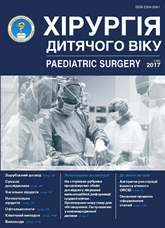Treatment of membranous atresia of the stomach, combined with epidermolysis bullosa, in newborns. a literature overview and own observations
DOI:
https://doi.org/10.15574/PS.2017.55.92Keywords:
gastric atresia, pyloric web, epidermolysis bullosa, newbornsAbstract
The article presents literature data on prevalence, clinical picture, diagnosis, treatment and prognosis of associated birth defects – membranous pyloric atresia and epidermolysis bullosa in newborns. Two own observations of these severe defects are also given. The authors concluded that the presence of epidermolysis bullosa in a neonate requires a follow-up examination concerning possible pyloric atresia. The prognosis for the combined stomach atresia and epidermolysis bullosa largely depends upon the severity of the digestive tract and upper respiratory tract lesions, as well as septic complications.References
Ashcraft KW, Holder TM. (1996). Pediatric surgery. SPb. Hardford. 1: 384.
Al-Salem AH. (2007). Congenital pyloric atresia and associated anomalies. Pediatr Surg Int. 23: 559–563. https://doi.org/10.1007/s00383-007-1903-0; PMid:17390140
Chung HJ, Uitto J. (2010). Epidermolysis Bullosa with Pyloric Atresia. Dermatol Clin. 28(1): 43–54. https://doi.org/10.1016/j.det.2009.10.005; PMid:19945615 PMCid:PMC2790914
Nakamura H, Sawamura D, Goto M et al. (2005). Epidermolysis bullosa simplex associated with pyloric atresia is a novel clinical subtype caused by mutations in the plectin gene (PLEC1). J Mol Diagn. 7:28–35. https://doi.org/10.1016/S1525-1578(10)60005-0
Maman E, Maor E, Kachko L, Carmi R. (1998). Epidermolysis bullosa, pyloric atresia, aplasia cutis congenital:histopathological delineation of an autosomal recessive disease. Am J Med Genet. 78(2): 127-133. https://doi.org/10.1002/(SICI)1096-8628(19980630)78:2<127::AID-AJMG6>3.0.CO;2-L
Dank JP, Kim S, Parisi MA et al. (1999). Outcome After Surgical Repair of Junctional Epidermolysis Bullosa–Pyloric Atresia Syndrome. A Report of 3 Cases and Review of the Literature. Arch Dermatol. 135(10): 1243-1247. https://doi.org/10.1001/archderm.135.10.1243; PMid:10522673
Pfendner E, Uitto J. (2005). Plectin gene mutations can cause epidermolysis bullosa with pyloric atresia. J Invest Dermatol. 124(1): 111-115. https://doi.org/10.1111/j.0022-202X.2004.23564.x; PMid:15654962
Pulkkinen L, Kim DU, Uitto J. (1998). Epidermolysis bullosa with pyloric atresia: novel mutations in the beta4 integrin gene (ITGB4). Am. J. Pathol. 152(1): 157-166. PMid:9422533 PMCid:PMC1858138
El Shafie M, Klippel CH. (1979). Pyloric atresia and epidermolysis bullosa letalis: A lethal combination in two premature newborn siblings. J of Pediatric Surgery. 14(4): 446-449. https://doi.org/10.1016/S0022-3468(79)80012-3
Ilce Z, Erdogan E, Kara C et al. (2003). Pyloric atresia: 15-year review from a single institution. J of Pediatric Surgery. 38(11): 1581–1584. https://doi.org/10.1016/S0022-3468(03)00565-7
Downloads
Issue
Section
License
The policy of the Journal “PAEDIATRIC SURGERY. UKRAINE” is compatible with the vast majority of funders' of open access and self-archiving policies. The journal provides immediate open access route being convinced that everyone – not only scientists - can benefit from research results, and publishes articles exclusively under open access distribution, with a Creative Commons Attribution-Noncommercial 4.0 international license(СС BY-NC).
Authors transfer the copyright to the Journal “PAEDIATRIC SURGERY.UKRAINE” when the manuscript is accepted for publication. Authors declare that this manuscript has not been published nor is under simultaneous consideration for publication elsewhere. After publication, the articles become freely available on-line to the public.
Readers have the right to use, distribute, and reproduce articles in any medium, provided the articles and the journal are properly cited.
The use of published materials for commercial purposes is strongly prohibited.

